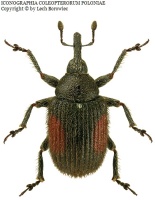Підтримуємо Вільну Україну
 We Support Free Ukraine
We Support Free Ukraine

Biodiversity Map
Taxa

Taxon count: 5
-
Rhinusa bipustulataSet as tree root ↑
Show taxon data → ⚑
 [76] → Show taxon data
[76] → Show taxon data -
Cionus spilotusSet as tree root ↑
Show taxon data → → Show taxon data -
Curculio bipustulatusSet as tree root ↑
Show taxon data → → Show taxon data -
Gymnetron bipustulatumSet as tree root ↑
Show taxon data → → Show taxon data -
Gymnetron bipustulatum var. sanguinipenneSet as tree root ↑
Show taxon data → → Show taxon data
-
Arthropodaphylum
Click to switch
to select orders
and filters > -
Hexapodasubphylum
Click to switch
to select orders
and filters > -
Insectaclass
Click to switch
to select orders
and filters > -
Coleopteraorder
Click to set
as the main taxon
and as a base
← of the left panel > -
Polyphagasuborder
Click to set
as the main taxon
and as a base
← of the left panel > -
Cucujiformiaseries
Click to set
as the main taxon
and as a base
← of the left panel > -
Curculionoideasuperfamily
Click to set
as the main taxon
and as a base
← of the left panel > -
Curculionidaefamily
Click to set
as the main taxon
and as a base
← of the left panel > -
Curculioninaesubfamily
Click to set
as the main taxon
and as a base
← of the left panel > -
Mecininitribe
Click to set
as the main taxon
and as a base
← of the left panel > -
Rhinusagenus
Click to set
as the main taxon
and as a base
← of the left panel >
species:
Rhinusa bipustulata
PL
YES
name status: valid name
BioMap ID: 1046376
taxon code: 5654
taxonomy checked: YES
Data on distribution in Poland

Statistics
- Records: 76
- Publications: 36
- Collections: 8
- Publication authors: 33
- Illustrations (iconography): 1
- Photos (specimen/observation): 2
Taxon description
Gatunek rozmieszczony w środkowej i południowej części Europy, wykazywany ponadto z Algierii, Turcji i Syrii. W Polsce jest notowany z nielicznych rozproszonych stanowisk, przy tym dane z niektórych krain opierają się tylko na pojedynczych znaleziskach. Spotykany na polach, przydrożach, przychaciach, piaszczystych i mulistych brzegach wód, w lasach i zaroślach. Żyje na lnicy pospolitej — Linaria vulgaris (L.) Mill., namulniku brzegowym – Limosella aquatica L. oraz trędowniku bulwiastym — Scrophularia nodosa L. Postacie dojrzałe poławiano na roślinach od maja do września. Samica w czerwcu-lipcu składa wiele jaj do jednego owocka. Larwy żerują w torebkach nasiennych i żywią się niedojrzałymi nasionami. Z końcem lipca pojawiają się poczwarki, wykazujące dużą ruchliwość. Stadium poczwarki trwa około dwóch tygodni.
Illustrations
... browse
 Rhinusa
Rhinusabipustulata
External data sources
- Ostatnie rekordy
-
1099444
 ×
× Curculionidae: Rhinusa bipustulata, PL, Otwock ad Warszawa, 1944, leg. A. Gottwald, coll. IBL, Zakład Ochrony Lasu, Sękocin: Gottwald
Curculionidae: Rhinusa bipustulata, PL, Otwock ad Warszawa, 1944, leg. A. Gottwald, coll. IBL, Zakład Ochrony Lasu, Sękocin: Gottwald -
805630
 ×
× Curculionidae: Rhinusa bipustulata, PL (Mazur 2011c)
Curculionidae: Rhinusa bipustulata, PL (Mazur 2011c) -
805629
 ×
× Curculionidae: Rhinusa bipustulata, PL (Kubisz et al. 1998b)
Curculionidae: Rhinusa bipustulata, PL (Kubisz et al. 1998b) -
805628
 ×
× Curculionidae: Rhinusa bipustulata, PL (Mazur 2006c)
Curculionidae: Rhinusa bipustulata, PL (Mazur 2006c) -
805627
 ×
× Curculionidae: Rhinusa bipustulata, PL (Mazur 2006d)
Curculionidae: Rhinusa bipustulata, PL (Mazur 2006d) -
805626
 ×
× Curculionidae: Rhinusa bipustulata, PL (Kuśka 2001d)
Curculionidae: Rhinusa bipustulata, PL (Kuśka 2001d) -
805625
 ×
× Curculionidae: Rhinusa bipustulata, PL (Łętowski et al. 2001b)
Curculionidae: Rhinusa bipustulata, PL (Łętowski et al. 2001b) -
805624
 ×
× Curculionidae: Rhinusa bipustulata, PL (Cmoluch 1992b)
Curculionidae: Rhinusa bipustulata, PL (Cmoluch 1992b) -
789772
 ⊡
⊡ Curculionidae: Rhinusa bipustulata, PL, Wyżyna Małopolska, łódzkie, Pabianice ad Łódź, UTM CC82, 1978, leg. C. Watała
Curculionidae: Rhinusa bipustulata, PL, Wyżyna Małopolska, łódzkie, Pabianice ad Łódź, UTM CC82, 1978, leg. C. Watała -
787736
 ⊡
⊡ Curculionidae: Rhinusa bipustulata, PL, Wyżyna Małopolska, łódzkie, Rogów ad Skierniewice, UTM DC24, 1977, leg. M. Wanat
Curculionidae: Rhinusa bipustulata, PL, Wyżyna Małopolska, łódzkie, Rogów ad Skierniewice, UTM DC24, 1977, leg. M. Wanat - ... more
- Powiązane publikacje
-
Mazur M.A. 2011c. Weevils (Coleoptera: Curculionoidea) of the Stobrawski Landscape Park. Pol. Pismo Ent., 80(2):321-342.
 full text
full text Show records
Show records -
Mazur M.A. 2006d. Weevils (Coleoptera: Curculionoidea: Anthribidae, Apionidae, Curculionidae, Rhynchitidae) of selected excavations of Opole Silesia. [In:] Nowak A., Hebda G. (Eds.) Biodiversity of quarries and pits. Opole Scientific Society, 3rd Department of Natural Sciences, Opole-Górażdże. pp. 145-161.
 Show records
Show records -
Mazur M.A. 2006c. Materiały do znajomości ryjkowców (Coleoptera: Curculionoidea: Apionidae, Curculionidae) Śląska. Wiad. Entomol., 25(4):225-232.
 full text
full text Show records
Show records -
Łętowski J., Gosik R., Staniec B., Czarniawski W. 2001b. Ryjkowcowate (Curculionidea: Rhinomaceridae, Attelabidae, Apionidae, Curculionidae) wybranych zespołów roślinnych Nadwieprzańskiego Parku Krajobrazowego. Parki Nar. Rez. Przyr., 20(4):47-66.
 Show records
Show records -
Kuśka A. 2001d. Ryjkowce (Coleoptera: Rhynchitidae, Apionidae, Nanophyidae, Curculionidae) terenów kserotermicznych Górnego Śląska. Nat. Sil. Sup., 5:61-77.
 Show records
Show records - ... more
- Powiązane zbiory
-
ISEZ PAN
 Show records
Show records -
Kuśka A.*
 Show records
Show records -
Stachowiak P.*
 Show records
Show records -
Wanat M.*
 Show records
Show records -
Mazur M.A.
 Show records
Show records - ... more
- Wykaz powiązanych pozycji
-
Curculionoidea of Poland
 Show records
Show records





